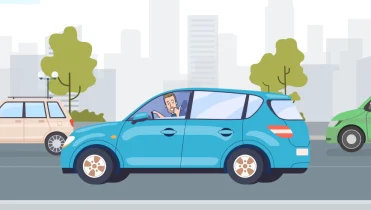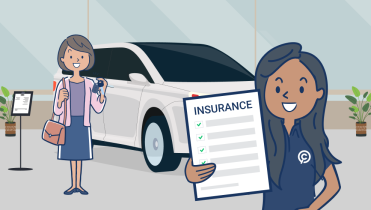less than
2 mins
- Home
- Personal Finance
- Guide
- Third Party Fire & Theft
Third Party Fire & Theft Car Insurance Comparison
If you’ve been searching for anything and everything to do with third party fire and theft car insurance in Australia, then you’ve come to the right place!
Here, we’ve compiled the most up-to-date information you’ll need to get to grips with this type of insurance and start comparing car insurance policies. Whether you're looking for a specific policy, want to know more about costs, or simply want to weigh the pros and cons against third party property damage or comprehensive car insurance, you’ll find it here.
You’ll find out more about third party fire and theft as we explain the following:
How Much Does Third Party Fire & Theft Cost?
What Does Third Party Fire & Theft Cover?
What is Excluded from Third Party Fire & Theft Car Insurance?
Who is Third Party Fire & Theft Right For?
Pros & Cons of Third Party Fire & Theft Insurance
Frequently Asked Questions
How Much Does Third Party Fire & Theft Insurance Cost?
For many drivers in Australia, cost is the most important factor when making a decision about insurance – no matter the type. Here are some of the factors that influence the cost of third party fire and theft insurance in Australia:
Learn more about car insurance with these guides
Factors Affecting the Cost of Third Party Fire & Theft Premiums
How much you end up paying for third party fire and theft in Australia will depend on how risky the insurer perceives you to be, as well as a variety of other factors. Here’s what may – or may not – change the cost of third party fire and theft insurance:
Vehicle value: How much your car is currently worth will play a big role in how much you are quoted for. Generally, the more expensive the vehicle, the higher the premiums. This is because a higher-value car is going to cost more to repair or replace.
Vehicle age and condition: Cars that are older generally pay lower premiums as their market value has decreased over the years. However, the condition of the vehicle itself, particularly its safety features, may also influence the final premium price.
Your age and experience: Younger and inexperienced drivers are considered higher risk, which can result in higher policy quotes. Car insurers often charge more to drivers who are under the age of 25 or those with very little driving experience.
Your driving history: Whether you have been involved in any accidents, as well as your history of car insurance claims, will influence your premiums. Drivers who have a history of accidents, speeding tickets/DUIs or have recently made claims are considered ‘high risk’ and usually face higher premiums compared to drivers with a clean record.
Location: Where your vehicle is kept (e.g. secure garage vs on-street parking) and where you live will also affects the overall insurance cost. Suburbs and cities with higher rates of accidents, theft or vandalism may have higher premiums as well. Be aware that busy areas like capital cities tend to have higher associated insurance costs compared to rural parts of the country – this is due to increased traffic and therefore greater risk of an incident occurring.
Security features: If your vehicle has working security features like a car alarm or engine immobiliser, then the insurer may consider it less likely to be stolen, which can mean lower premiums.
Usage: Take into account how you intend to use the vehicle, as well as how frequently you will use it. Cars used for business purposes or daily commuting may have higher premiums compared to vehicles that will only be used for weekend drives or the odd journey.
Additional drivers: Be aware that adding extra drivers to your policy – especially younger or inexperienced drivers – can increase the premium amount.
Every insurance provider will weigh up these factors according to their own standards, so it's recommended that you compare third party fire and theft car insurance quotes from multiple insurers to find the most competitive premiums. Using Compare Club is an easy way to compare and save on car insurance.
GET A QUICK QUOTEWhat Does Third Party Fire & Theft Cover?
Third party fire and theft insurance gives you cover for a variety of situations you and your vehicle might unfortunately find yourselves in. So if you’ve been looking for a simple breakdown of car insurance for third party fire and theft explained, here are some of the key features of this cover:
Third-party liability: You’re protected financially if you end up damaging someone else's property or vehicle in an accident where you are at fault. It covers the cost of repairs or replacement for the other party's vehicle or property, up to a set amount on the policy.
Fire damage: Third party fire and theft insurance includes cover for your vehicle in case it’s damaged or destroyed due to fire – whether it's a minor fire-related incident or major fire that leads to total loss.
Theft and attempted theft: One of the biggest advantages of third party fire and theft insurance is that if your vehicle is stolen or someone tries to steal it and damages it, you’re covered for the cost of repairs or replacement, up to the cover limit on your policy.
Towing expenses: In the event of an accident or theft and your car becomes undrivable, your policy may cover the cost of towing.
What’s Excluded from Third Party Fire & Theft Car Insurance?
Knowing about the exclusions in your policy will help you avoid any surprises when it comes to filing a claim. Here are some common exclusions with this type of insurance in Australia:
Damage to your own vehicle when you are at fault: One of the main exclusions of third party fire and theft insurance is that it doesn’t cover damage to your own car when you are at fault for an accident; since collision is the most common claimable incident with car insurance, this may potentially leave the owner of the vehicle significantly out of pocket.
Damage caused by flood, storm or natural disasters: Third party fire and theft insurance doesn’t usually cover damage caused by natural disasters like floods, storms or other severe weather-related events. If you live in an area prone to heavy rainfall, then you might want to look for higher-level coverage like a comprehensive car insurance policy.
Mechanical breakdowns or wear and tear: With third party fire and theft insurance, you won’t get any financial assistance for breakdowns or damage caused by normal wear and tear. It’s up to you to properly maintain your vehicle and take care of any mechanical issues before they start causing serious problems. It is common that a vehicle owner will take out a “Roadside Assistance” policy; or pay an additional sum to add to their insurance cover, in the event that they need to rely on services when mechanical breakdown, in particular, occurs.
Damage to personal belongings inside your car: Personal items like electronics, clothing or other items that end up being damaged or stolen from your car aren’t usually covered under third party fire and theft insurance. However, some policies may offer this as an additional benefit you can take out at a cost, so do your research and always read the PDS before selecting a new policy. Please note: cover won't apply if you have not secured your vehicle when unattended.
Who is Third Party Fire & Theft Right For?
Third party fire and theft car insurance might be the right fit if you:
Have an older vehicle: If you drive an older vehicle that no longer has a high market value, then it may not be financially practical to invest in comprehensive insurance. Third party fire and theft insurance can provide all the cover you need for theft and fire damage, as well as offering protection if you damage someone else’s vehicle in an accident.
Want lower insurance premiums: Comprehensive insurance offers the highest level of coverage – but that comes at the cost of much higher premiums. If you find that comprehensive insurance is disproportionately expensive compared to the value of your vehicle, third party fire and theft insurance can be a more affordable solution.
Specifically want protection against theft or fire damage: If you are concerned about the potential loss of your car due to theft or fire but don’t want to pay for comprehensive insurance, third party fire and theft can be an attractive option.
Are budget-conscious and want a balance between cost and cover: If you are on a tight budget or simply don’t want to fork out for comprehensive car insurance premiums, third party fire and theft insurance offers a balance between cost and cover while still giving you financial protection.
Pros & Cons of Third Party Fire & Theft Insurance
Here are some pros and cons of third party fire and theft to help you figure out whether it’s the right policy type for you:
Pros:
Cover for a range of potential incidents: Third party fire and theft insurance offers financial protection if you cause damage to someone else’s property or vehicle in an accident, as well as the cost of repairs or replacement to your own car if it’s damaged or destroyed due to fire or theft.
More affordable than comprehensive insurance: Compared to comprehensive insurance, third party fire and theft insurance comes with substantially lower premiums, which can be a deciding factor for many budget-conscious Australian drivers.
Cons:
No cover for damage to your own car in at-fault accidents: One limitation of third party fire and theft insurance is that you won’t be financially protected if your own car is damaged and you are at fault in an accident. Third party fire & theft cover only covers damage to third party property & vehicles in an accident where you are not at fault.
Excludes coverage for natural disasters: Third party fire and theft car insurance also doesn’t cover damage caused by natural disasters, such as floods or storms. If you live in a part of Australia that’s prone to these events, you might want to think about getting extra coverage with a more comprehensive car insurance policy.
Make sure you take enough time to weigh the pros and cons against your individual needs to make the best decision for yourself.
How to Compare and Find Affordable Third Party Fire & Theft Car Insurance
Looking for the cheapest third party fire and theft car insurance around? Here’s what you’ll need to do in order to find an insurer who can fit within your budget and give you the level of cover you’re after:
Compare quotes from multiple insurers: Because prices for this type of car insurance will change from insurer to insurer, take the time to compare third party fire and theft car insurance quotes from a number of companies to find the best deal. Compare Club can make your life easier by taking care of all the heavy lifting for you.
Customise the excess amount: The amount you agree to pay towards a claim is known as the ‘excess’. By opting for a higher excess, you can end up with cheaper premiums over the long term. However, you’ll want to choose an excess amount that you can easily pay in the event you need to make a claim.
Consider nominating your drivers: Some insurers will lower their premiums if you nominate the specific drivers who will be using your car. It’s a good idea to limit the number of drivers nominated and ensure they are all aged over 25, and in some instances, you can nominate and ensure drivers are all aged over 40+; to reduce premium even further.
Boost vehicle security: Want lower premiums? Then make sure your car is secure! Installing alarms, immobilisers and tracking systems can deter would-be thieves and reduce the risk of damage. Parking your car in the garage, for example, as opposed to on the street, will also be viewed favourably by insurers.
Explore bundled insurance options: If you already have another type of insurance with a specific company, you might be able to take out third party fire and theft Car insurance in addition to your home or life insurance, for example. Bundling insurance is a good way to take advantage of special offers or discounts that may be offered by the insurer, while also giving you lower premiums for the foreseeable future.
What's new in car insurance - Feb 2025
Cheaper cover: A few providers have slashed prices for comprehensive policies.
EV insurance: Cover options are expanding as more Aussies go electric.
Tech-driven savings: Telematics are driving discounts for safer drivers.
Frequently Asked Questions
What is Third Party Fire & Theft Car Insurance?
Third party fire and theft car insurance is a type of coverage that will financially protect you in the event you damage someone else’s property or vehicle in an accident, as well as fire damage and theft of your own vehicle. It can be a good middle ground between comprehensive insurance and third party property damage insurance.
Can You Still Get Third Party Fire & Theft Insurance?
Yes, many insurance providers in Australia offer third party fire and theft car insurance. You can compare different car insurance policies with Compare Club and choose the one that best suits your needs.
Is Third Party Insurance the Same as Third Party Fire & Theft?
No, third party insurance typically refers to third party property damage insurance, which only covers damage caused to other people's property or vehicles. Third party fire and theft insurance is a step up in the level of cover.
GET A QUICK QUOTEReady to find the right third party fire and theft policy for your needs? You can start comparing and saving on car insurance today with Compare Club.
Things You Should Know
Compare Club Car Insurance is an online financial comparison service and is owned and operated by Compare Club Australia Pty Ltd (ACN 634 600 007). Compare Club does not compare all brands or all products offered by all brands.
The financial products compared on this website do not necessarily compare all features that may be relevant to you. Please check with a financial professional before you make any major financial decisions.
Any advice given here is general and has been prepared without considering your current objectives, financial situation or needs. Therefore, before acting on this advice, you should consider the appropriateness of the advice having regard to those objectives, situation or needs.
You should consider the insurers PDS prior to making the decision to purchase their product. For more information please read our Financial Services Guide (FSG) which contains further information about how our service works and how we make money.
Paul Coughran is the General Manager of Emerging Verticals at Compare Club. Paul has over 20 years of experience across a wide range of industries including Banking and Finance, Telecommunications and Energy. Paul leads a team of trusted experts dedicated to helping individuals make informed decisions about their insurance and utilities needs.

Meet our car insurance expert, Paul Coughran
Paul's top car insurance tips:
- 1
Regularly compare your insurance policies – You could be paying for cover you don’t need. Shopping around every so often can save you a fair bit, maybe even hundreds each year.
- 2
Don’t just look at the premium—check the excess too. While a higher excess might bring down your premium, remember you’ll have to fork out more if you do need to claim.
- 3
Double-check what’s included in your policy. Extras like windscreen cover or roadside assistance might not be part of the deal and could cost you more.
- 4
If you don’t drive much, consider usage-based insurance. Some policies base your cost on how much you actually drive, if you work from home or only use your car for short trips this might be a much better option.



